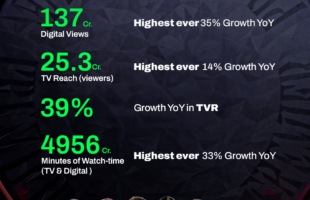Zee Entertainment, the Indian broadcaster targeting a billion viewers worldwide by 2020, has initiated a major push to open up revenue opportunities in Africa, while also launching its SVOD service, Zeefamily, in Asia-Pacific.
Zee’s first bespoke channel for the sub-Saharan marketplace, an English GE offering called Zee World, officially went on air in about 6.6 million homes, carried on DTH and DTT networks from DSTV, a service run by South Africa-based pay-TV group, MultiChoice.
DSTV’s reach lands Zee World in about 3.7 million homes in South Africa, and a further 2.9 million homes in the rest of Africa, including a sizable footprint in Nigeria.
Zee executives, seeking additional distribution deals for Zee World, want to see the channel in about 10 million sub-Saharan homes by the end of year.“This is our first offering [in Africa] targeting a mainstream audience,” Zee’s Africa’s CEO, Harish Goyal, told Media Business Asia. “We have more to come for South Africa, West Africa, East Africa and Francophone Africa,” Goyal added.
Next up will be a custom-made general entertainment channel for French-speaking Africa, also slated to make its debut this year, as well as local content produced for Zee World.
Moves into the mainstream
These channels, continuing Zee’s drive to extend its reach to non-Indian audiences, are being programmed on the back of market research into local tastes, airing selected content from Zee’s library, dubbed in-market using local talent.
Having reached near-saturation with channels catering to the Indian diaspora, Zee has started building out its presence with an international portfolio of localised offerings that already covers the Middle East, Russia and Southeast Asia (Zee Bioskop in Indonesia; Zee Variasi in Malaysia; and Zee Nung in Thailand).
International subscriptions contribute a sizable 11% of Zee’s line, about Rs40 billion (US$657 million), but growth has largely plateaued, prompting the media major to prospect local ad markets for additional momentum.
While Africa offers Zee some affiliate revenue for example, the pay-TV marketplace there is trending towards increased dependence on advertising, heightening Zee’s localisation drive.
“Subscriptions are saturating,” Goyal explained. “The major growth we are targeting, in line with the market dynamics, is largely coming from ad sales.”
Online subs opportunity
At the same time, Zee is shoring up its services for global South Asian audiences, extending the roll-out of its SVOD service, Zeefamily, to Asia-Pacific.
The app, first test-launched in the U.S. last September, is now available in six Asia-Pacific markets: Singapore, Thailand, Hong Kong, Australia, New Zealand and Japan.
After a free 30-day trial, the app will cost between U.S.$5-10/month for different packs, offering 25 channels (including Indonesia’s Zee Bioskop and Thailand’s Zee Nung as a la carte options) across Hindi and other Indian languages such as Marathi and Bengali, with a catch-up service, plus a library of on-demand movies.The app is also being tested in Europe, but no launch date has been confirmed.
“We are targeting 10% penetration of the South Asian diaspora outside India within the next three years,” said Zee’s SVP of international business for APAC, Tripta Singh.
“The South Asian diaspora outside India currently consists of around two million affluent South Asian consumers in key Asia-Pacific markets,” Singh added. “We also have plans to launch the app in other countries within APAC, depending on consumers’ uptake of the app and their feedback.”
At the end of its 2014 financial year, Zee’s global footprint stood at 730 million viewers, up from 670 million a year earlier. The broadcaster operates 34 channels in India, and a further 34 for overseas markets.








